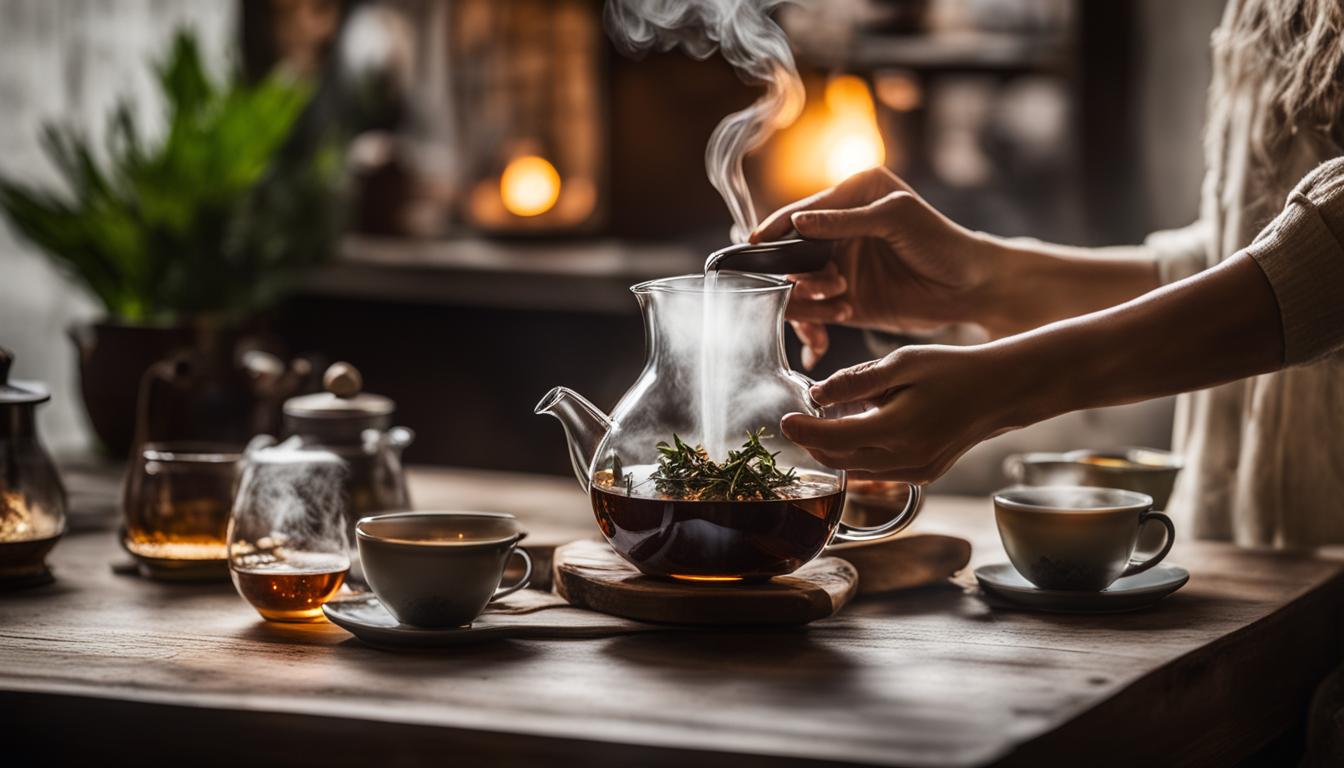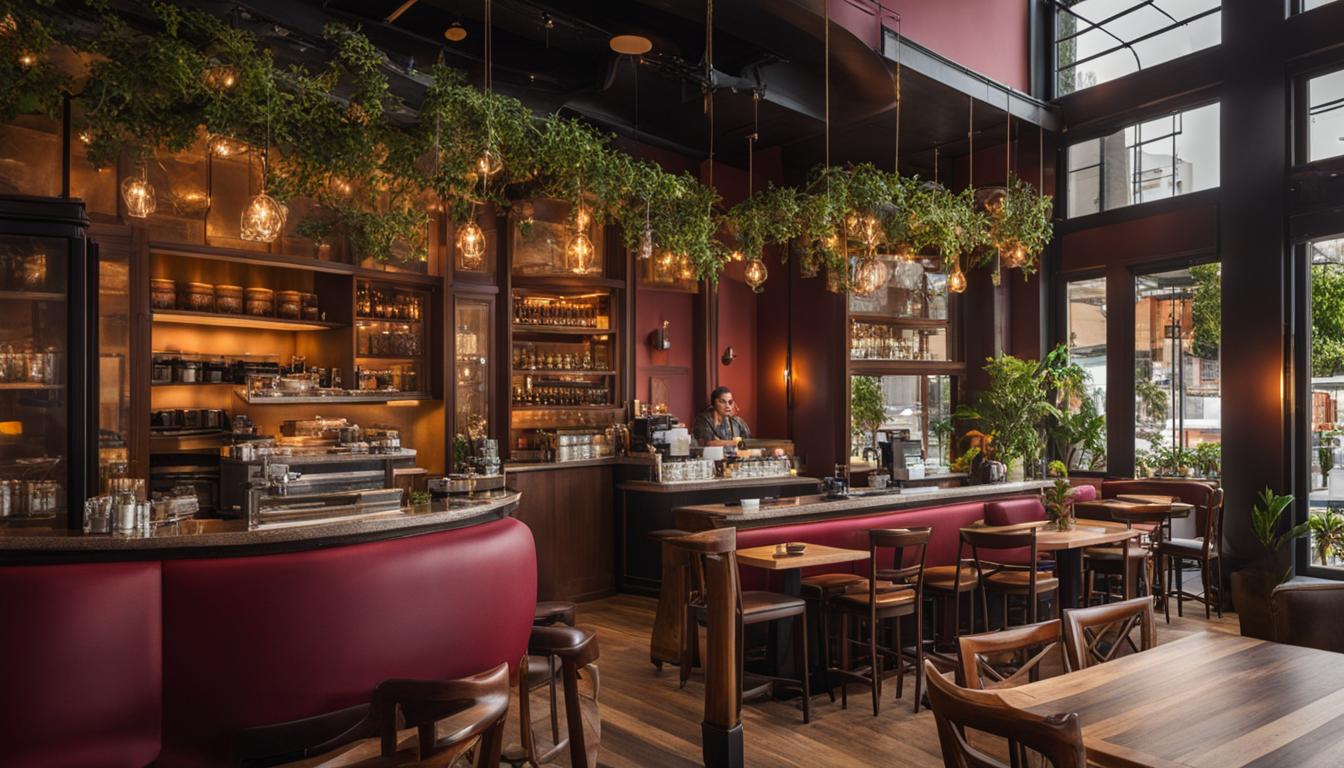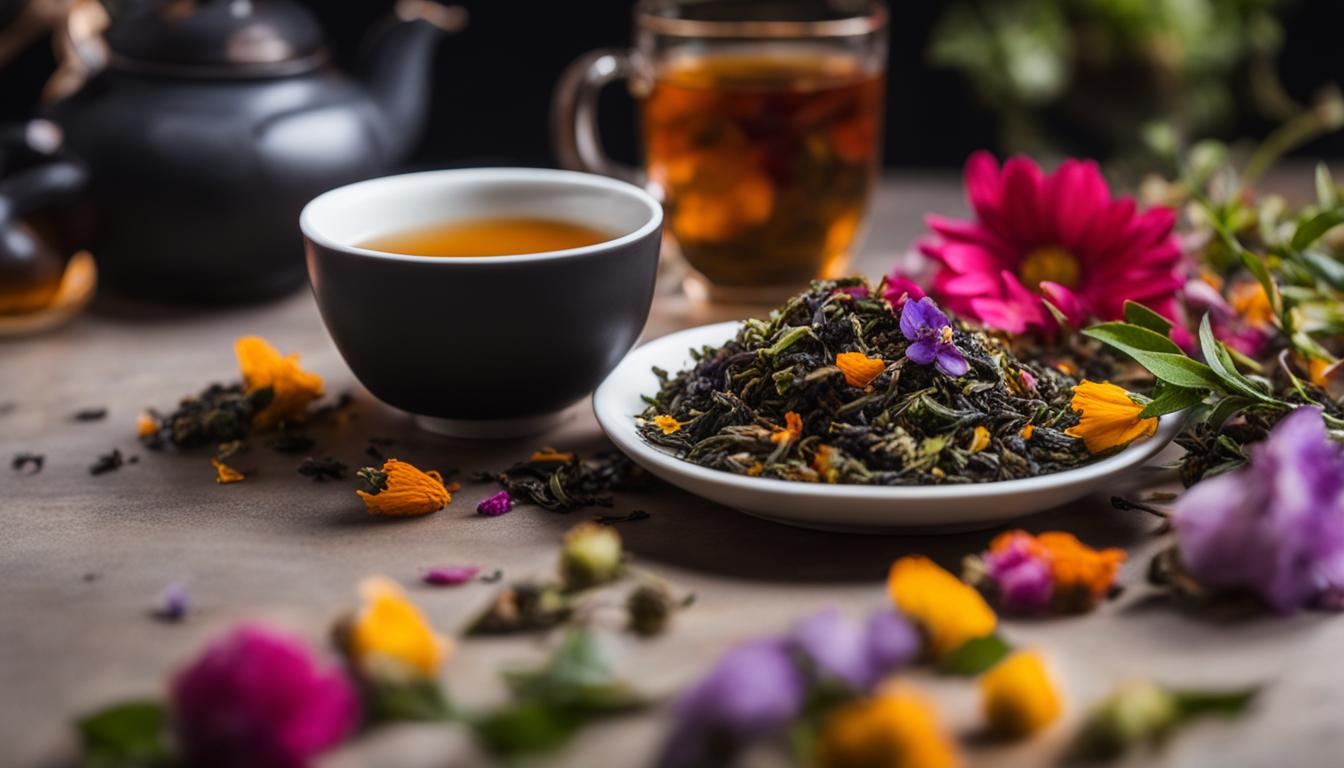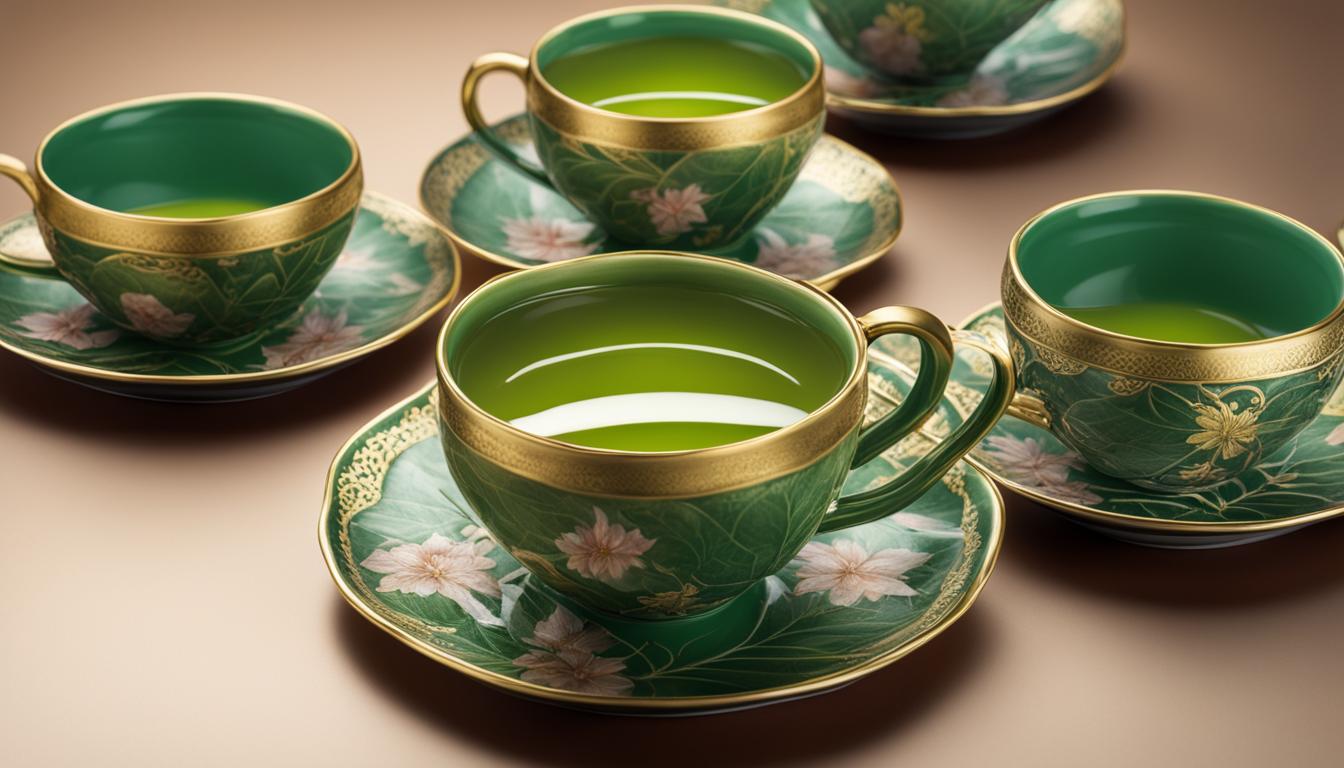Welcome to our comprehensive guide on mastering the art of brewing artisanal teas. We believe that tea brewing is not just a simple process but an art form that requires attention to detail and a deep understanding of the brewing process. In this guide, we will take you on a journey exploring the history of tea brewing, the health benefits it offers, the basics of tea brewing, and the equipment needed for the perfect brew. We will also delve into the different types of tea and their brewing methods, advanced brewing techniques, and the creation of a personalized tea brewing ritual. So, grab your teapot and let’s dive in!
Key Takeaways:
- Artisanal tea preparation methods require attention to detail and precision.
- Understanding the perfect tea brewing temperatures is crucial for a flavorful cup.
- Mastering tea infusions allows you to create unique and personalized flavor profiles.
- Exploring different types of tea and their brewing methods opens up a world of flavors.
- Creating a personalized tea brewing ritual enhances the overall tea experience.
The History and Significance of Tea Brewing
Tea brewing is not just a simple act; it embodies a rich history dating back centuries, making it a significant cultural practice in various parts of the world. The art of tea brewing originated in China during the 3rd century BC and quickly spread to other regions, adapting to diverse customs and traditions.
Tea brewing is considered an art form because it allows individuals to create a unique and personalized taste experience. It requires patience, precision, and creativity, making it a delightful practice for both the brewer and the drinker. The history and evolution of tea brewing are intertwined with the development of tea as a commodity and its cultural significance.
The art of tea brewing has transcended beyond the simple act of making a beverage. It has become a symbol of hospitality, connection, and mindfulness. Tea brewing rituals are often shared among communities and passed down through generations, preserving cultural identity and heritage. The process itself involves various techniques and practices, such as controlling water temperature, steeping times, and the selection of tea leaves, creating a beautifully complex and satisfying experience for tea enthusiasts.
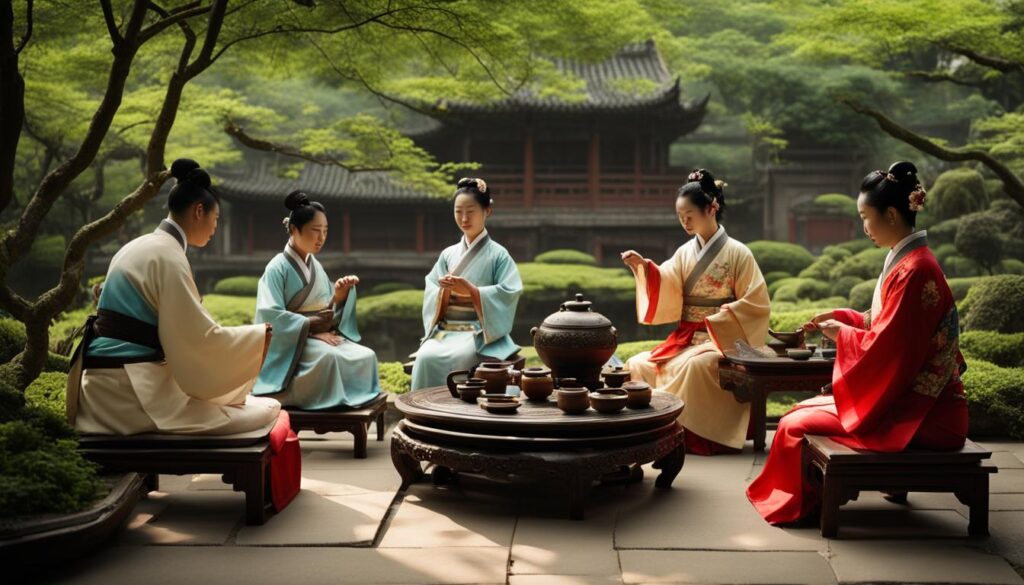
The Fascinating Journey of Tea Brewing
“Tea is not a mere drink but an elixir that delights the senses, nourishes the body, and soothes the soul.”
Tea brewing has not only remained a cherished tradition but has also adapted and evolved over time. From ancient methods like steeping tea in a gaiwan to modern innovations such as tea infusers and electric kettles, tea brewing techniques continue to evolve to suit the needs and preferences of tea enthusiasts worldwide. Each brewing method brings its own unique flavors and aromas to the tea, allowing for endless possibilities and discoveries.
Tea Brewing as a Reflection of Culture
The significance of tea brewing goes beyond the act itself. It reflects the culture, history, and values of the communities that practice it. In many countries, tea brewing ceremonies are considered sacred rituals, creating an atmosphere of serenity and tranquility. For example, the Japanese tea ceremony, known as “chado” or “the way of tea,” is a highly intricate and contemplative practice that focuses on mindfulness, harmony, and respect.
Preserving Tradition and Embracing Innovation
While tea brewing has deep roots in tradition, it also embraces innovation and experimentation. Tea enthusiasts are constantly exploring new techniques, tools, and flavors to enhance their brewing experience. From cold brewing to tea pairing with food, the possibilities are endless. The beauty of tea brewing lies in its ability to adapt and evolve while keeping its essence intact.
The Health Benefits of Tea Brewing
Tea brewing not only offers a delightful range of flavors and aromas but also provides numerous health benefits. By incorporating tea into your daily routine, you can reduce the risk of chronic illnesses, promote stress reduction, and enhance mental alertness.
One of the key advantages of tea brewing is its rich antioxidant content. Antioxidants help protect the body against damage from harmful free radicals, reducing the risk of chronic illnesses such as cancer and heart disease. By enjoying a cup of tea each day, you can support your immune system and improve your overall well-being.
In addition to its antioxidant properties, tea brewing is also known for its calming effects. The act of brewing and savoring a cup of tea can promote stress reduction and relaxation. The soothing ritual of preparing tea allows you to take a moment for yourself, unwind, and find tranquility amidst a busy day.
Tea is the elixir of life, offering not just a refreshing beverage, but a natural remedy for the body and mind.
Furthermore, tea brewing can enhance mental alertness, providing a gentle pick-me-up throughout the day. The combination of caffeine and theanine found in tea promotes focus and concentration, without the jittery side effects often associated with coffee. It’s the perfect beverage to keep you energized and centered.
| Health Benefits of Tea Brewing | Tea Types |
|---|---|
| Reduces the risk of chronic illnesses | Green tea, black tea, oolong tea, white tea |
| Promotes stress reduction and relaxation | Chamomile tea, lavender tea, peppermint tea |
| Enhances mental alertness | Matcha tea, yerba mate tea |
By incorporating the art of tea brewing into your daily routine, you can enjoy the multitude of health benefits it offers. From reducing chronic illnesses to promoting stress reduction and mental alertness, tea brewing is a delightful practice that nourishes both the body and mind.
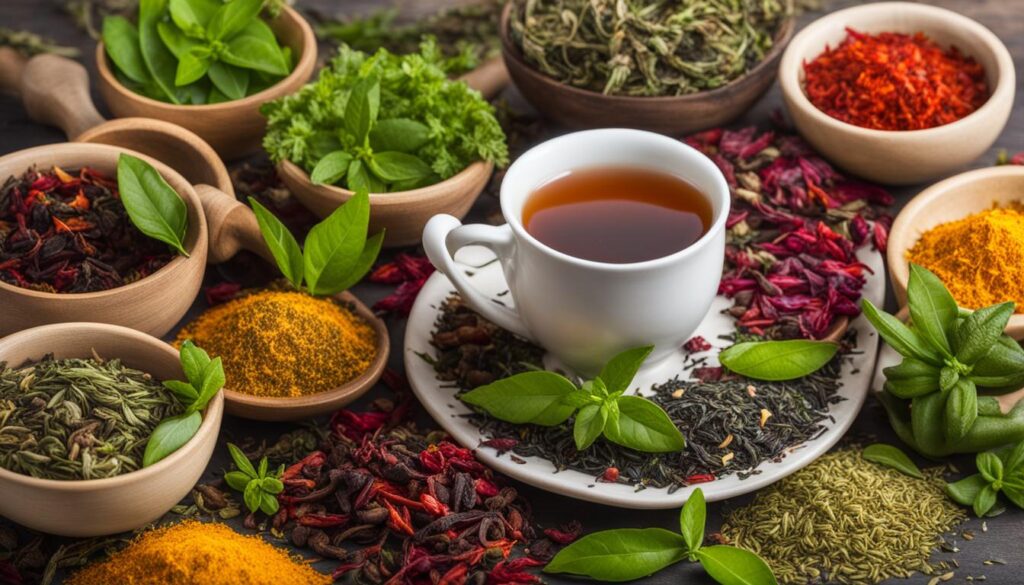
The Basics of Tea Brewing
Before we embark on the journey of exploring different types of tea and their brewing techniques, it is essential to master the basics of tea brewing. Understanding the optimal temperatures and water quality plays a crucial role in achieving the perfect cup of tea.
Optimal Temperatures
Each type of tea requires specific water temperatures to bring out its unique flavors and aromas. Here’s a handy guide to help you brew your favorite teas:
- Green tea: 160-180°F (71-82°C)
- Black tea: 200-212°F (93-100°C)
- Oolong tea: 190-200°F (88-93°C)
- White tea: 160-180°F (71-82°C)
- Herbal tea: 200-212°F (93-100°C)
By carefully adjusting the water temperature, you can unlock the full potential of each tea variety and savor its distinct taste.
Water Quality
The quality of water used for brewing tea greatly impacts the final flavor. Ideally, use filtered or purified water to ensure a clean and refreshing taste. Tap water may contain impurities that can alter the flavor of your tea.
If possible, avoid using distilled water as it lacks the minerals necessary for enhancing the tea’s taste. Remember, the water you choose should complement the tea, not overpower it.
| Water Source | Quality |
|---|---|
| Tap water | Avoid if high in chlorine or other impurities |
| Filtered water | Recommended for a clean and pure taste |
| Purified water | An excellent choice for removing impurities |
| Distilled water | Not recommended, lacks necessary minerals |
By keeping these basic principles in mind, you’ll be well on your way to brewing a delicious cup of tea that fully embodies the flavors and aromas of your chosen variety.
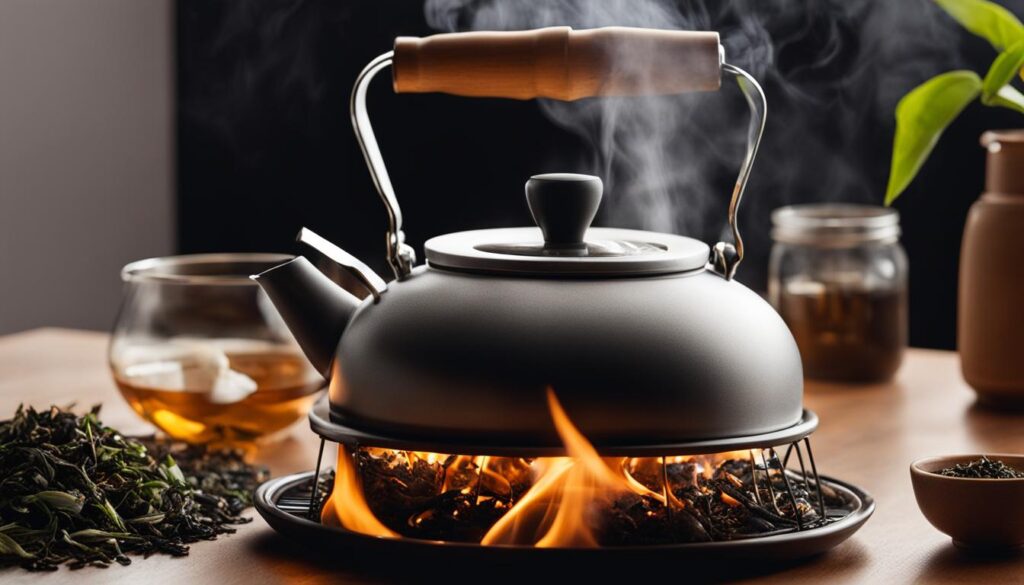
Exploring Different Types of Tea and Brewing Techniques
Tea aficionados know that the world of tea is vast and diverse, offering a wide range of flavors, aromas, and health benefits. In this section, we will dive into the different types of tea and explore the unique brewing techniques that bring out their best qualities. From the delicate flavors of green tea to the robustness of black tea, there’s a tea variety for every palate. Let’s embark on a journey to discover the wonders of green tea, black tea, oolong tea, white tea, and herbal tea.
Green Tea
Green tea, known for its fresh and grassy taste, is a favorite among health-conscious individuals. It originates from China and Japan and is rich in antioxidants that promote overall well-being. Brewing green tea requires delicate care, as it is sensitive to high temperatures. The optimal water temperature for brewing green tea is around 160-180°F (70-82°C), and steeping it for 2-3 minutes ensures a light and flavorful cup.
Black Tea
Black tea is the most widely consumed tea globally, known for its bold and robust flavor. It undergoes a full oxidation process, resulting in its dark color and rich taste. To brew black tea, use water heated to a rolling boil, around 200-212°F (93-100°C), and steep it for 3-5 minutes for a strong and invigorating cup. It pairs well with milk and sugar, making it perfect for breakfast or afternoon tea.
Oolong Tea
Oolong tea lies between green tea and black tea in terms of oxidation. It offers a wide range of flavors, from floral and fruity to nutty and complex. The ideal water temperature for brewing oolong tea is around 180-200°F (82-93°C), and the steeping time can vary depending on the desired strength, ranging from 2-5 minutes. Experimenting with different steeping times and water temperatures allows you to unlock the nuances of oolong tea.
White Tea
White tea is the least processed of all teas, known for its delicate and subtle flavors. It is harvested when the young tea leaves are still covered in fine white hairs, hence the name “white tea.” For the best brewing results, use water heated to around 175-185°F (79-85°C) and steep it for 1-3 minutes. The gentle brewing process allows the flavors of white tea to shine through, resulting in a light and refreshing cup.
Herbal Tea
Herbal tea, also known as tisanes, is not made from the leaves of the Camellia sinensis plant like other teas but is instead crafted from various flowers, herbs, and spices. There is a wide variety of herbal teas available, each offering unique flavors and health benefits. The brewing techniques for herbal tea can vary depending on the ingredients, but most herbal teas require boiling water and steeping times ranging from 5-10 minutes. From soothing chamomile to invigorating peppermint, herbal teas provide a delightful and caffeine-free option for tea enthusiasts.
| Tea Variety | Water Temperature | Steeping Time |
|---|---|---|
| Green Tea | 160-180°F (70-82°C) | 2-3 minutes |
| Black Tea | 200-212°F (93-100°C) | 3-5 minutes |
| Oolong Tea | 180-200°F (82-93°C) | 2-5 minutes |
| White Tea | 175-185°F (79-85°C) | 1-3 minutes |
| Herbal Tea | Boiling water | 5-10 minutes |
Whether you prefer the delicate flavors of green tea, the boldness of black tea, the complexity of oolong tea, the subtlety of white tea, or the herbal goodness of tisanes, there’s a tea variety to suit every taste. By exploring the different types of tea and mastering the brewing techniques specific to each, you can unlock a world of flavors and create a personalized tea experience that satisfies both your palate and your soul.
Advanced Tea Brewing Techniques and Personalized Rituals
Now that you have mastered the basics of tea brewing, it’s time to take your skills to the next level with advanced brewing techniques and personalized rituals. These techniques will allow you to unlock new flavors and create a unique tea experience tailored to your taste.
One advanced brewing technique to explore is cold brewing. This method involves steeping tea leaves in cold water for an extended period, typically overnight. Cold brewing results in a smooth and refreshing tea with less bitterness and a naturally sweet flavor. It’s a perfect option for hot summer days or when you want a refreshing iced tea.
A different approach to tea brewing is the art of gong fu brewing. This traditional Chinese method involves using a small teapot, multiple short infusions, and precise pouring techniques. Gong fu brewing allows you to fully appreciate the nuances of the tea’s flavor profile and create a multi-layered experience. It’s a beautiful and meditative ritual that brings out the best in high-quality teas.
As you explore advanced brewing techniques, don’t forget to personalize your tea ritual. Create a dedicated space for tea brewing and set the ambiance with soothing music or candles. Experiment with different tea infusers, such as glass or ceramic ones, to enhance the visual appeal of your brewing process. Pair your favorite teas with complementary flavors, like dark chocolate with oolong tea or citrus fruits with green tea, to elevate your tea tasting experience.
The Art of Tea Pairing
Tea pairing is an art form that involves harmonizing the flavors and aromas of tea with various food items. Just like wine pairing, tea pairing allows you to enhance the taste experience and discover new flavor combinations. Here are a few tea pairing suggestions to get you started:
- Pair a delicate white tea with fresh berries for a light and refreshing combination.
- Enjoy a floral oolong tea alongside honey-glazed pastries for a sweet and fragrant treat.
- Match a robust black tea with dark chocolate for a rich and indulgent pairing.
- Savor a smoky Lapsang Souchong tea with grilled meats for a bold and savory experience.
Remember, tea pairing is a personal journey, and there are no strict rules. Trust your taste buds and let your creativity guide you as you explore unique flavor combinations.
“Tea is more than just a beverage; it’s a sensory experience. Embrace the art of tea brewing, and create your own personalized rituals. Experiment with advanced brewing techniques, elevate your tea tasting with thoughtful pairings, and savor each sip as you embark on a journey of discovery.”
– Unknown
So, whether you choose to indulge in the tranquility of gong fu brewing, explore the refreshing world of cold brewing, or create your own personalized tea pairing rituals, the key is to enjoy the process and embrace the artistry of tea brewing. Let your tea journey unfold, one cup at a time.
| Tea Brewing Techniques | Description |
|---|---|
| Cold Brewing | Steeping tea leaves in cold water for an extended period, resulting in a smooth and refreshing tea with a naturally sweet flavor. |
| Gong Fu Brewing | A traditional Chinese method involving a small teapot, multiple short infusions, and precise pouring techniques to fully appreciate the tea’s flavor profile. |
The Art of Japanese Tea Ceremony
Immerse yourself in the elegant and serene world of the Japanese tea ceremony, known as “chado” or “the way of tea.” This highly ritualized practice is deeply rooted in Japanese culture and offers a unique and meditative tea experience. At the center of the ceremony is matcha, a vibrant green powdered tea with a rich history and distinctive flavor.
To fully appreciate the art of the Japanese tea ceremony, it is important to understand the significance of the various tea utensils used. These include the chawan (tea bowl), chasen (bamboo whisk), chashaku (tea scoop), and kusenaoshi (tea whisk holder). Each utensil has its own purpose and symbolizes the harmony between nature, the tea host, and the guests.
The Tea Serving Etiquette
The Japanese tea ceremony follows a specific etiquette that embodies respect, humility, and mindfulness. Guests are expected to cleanse their hands and mouth before entering the tea room and to bow to show gratitude and appreciation. The host meticulously prepares and serves the tea, while guests observe in quiet contemplation. It is customary for guests to rotate the tea bowl clockwise before taking a sip to appreciate its craftsmanship.
“The simplicity and grace of the Japanese tea ceremony create a serene atmosphere that allows us to escape the chaos of everyday life and find tranquility in each sip.”
The Japanese tea ceremony is not just about drinking tea but also about fostering a sense of mindfulness and connection. It encourages us to slow down, appreciate the present moment, and find beauty in simplicity. By embracing the art of the tea ceremony, we can cultivate a deeper appreciation for tea and its ability to nourish the body, mind, and spirit.
| Utensil | Description |
|---|---|
| Chawan | A bowl used for preparing and serving matcha tea. |
| Chasen | A bamboo whisk used to froth the matcha tea. |
| Chashaku | A tea scoop used to measure the correct amount of matcha. |
| Kusenaoshi | A tea whisk holder used to maintain the shape and integrity of the bamboo whisk. |
Conclusion
We hope that this comprehensive guide has inspired you to embark on the journey of brewing artisanal teas. By mastering tea brewing techniques and exploring the diverse world of tea varieties, you can create a truly unique and personalized tea experience. Whether you prefer the floral notes of green tea, the boldness of black tea, the smoothness of oolong tea, or the soothing qualities of herbal tea, the possibilities are endless.
Remember, brewing artisanal teas is not just about the end result; it’s about the process itself. It’s about taking the time to truly appreciate the flavors, aromas, and health benefits that each cup of tea offers. So, gather your favorite tea equipment, set the perfect brewing temperature, and let your taste buds embark on a flavor adventure.
With practice, patience, and a touch of creativity, you can become a master tea brewer. Embrace the soothing ritual of tea making, and let this ancient art form bring joy and tranquility to your everyday life. So, raise your cup and toast to the endless possibilities of brewing artisanal teas. Cheers!
FAQ
What is the history of tea brewing?
Tea brewing has a rich history dating back centuries, originating in China during the 3rd century BC. It quickly spread to different parts of the world, adapting to diverse customs.
What are the health benefits of tea brewing?
In addition to its delightful flavors, tea brewing is rich in antioxidants and aids in bolstering the immune system, reducing the risk of chronic illnesses such as cancer and heart disease. It also promotes stress reduction, enhances mental alertness, and promotes relaxation.
What are the basics of tea brewing?
The basics of tea brewing include understanding the necessary equipment, optimal temperatures, brewing times, and the importance of water quality. Each type of tea requires specific temperatures and brewing times to unlock its full potential, and using purified or filtered water ensures the best flavor and aroma.
What are the different types of tea and their brewing methods?
We will explore the origins and health benefits of green tea, black tea, oolong tea, white tea, and herbal tea. Each tea variety requires specific water temperatures and brewing times to bring out its distinctive flavors and aromas.
What are some advanced tea brewing techniques?
For those looking to take their tea brewing skills to the next level, we will delve into advanced brewing techniques such as cold brewing and gong fu brewing. We will also explore the art of tea pairing, where the flavors and aromas of tea are harmonized with various food items. Additionally, we will discuss the use of tea infusers and the benefits of creating a personalized tea brewing ritual.
What is the Japanese tea ceremony?
The Japanese tea ceremony, known as “chado” or “the way of tea,” is a highly ritualized practice that involves the preparation and serving of matcha tea. We will explore the history and significance of the tea ceremony, the required utensils, and the proper tea serving etiquette. This section will provide insights into creating a meditative and calming tea experience at home.

